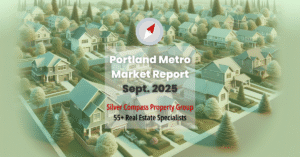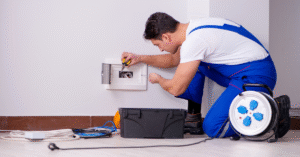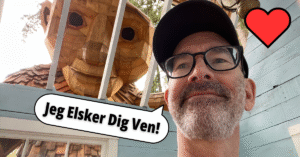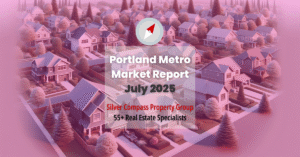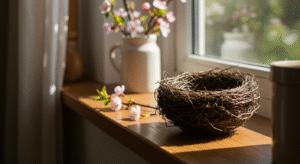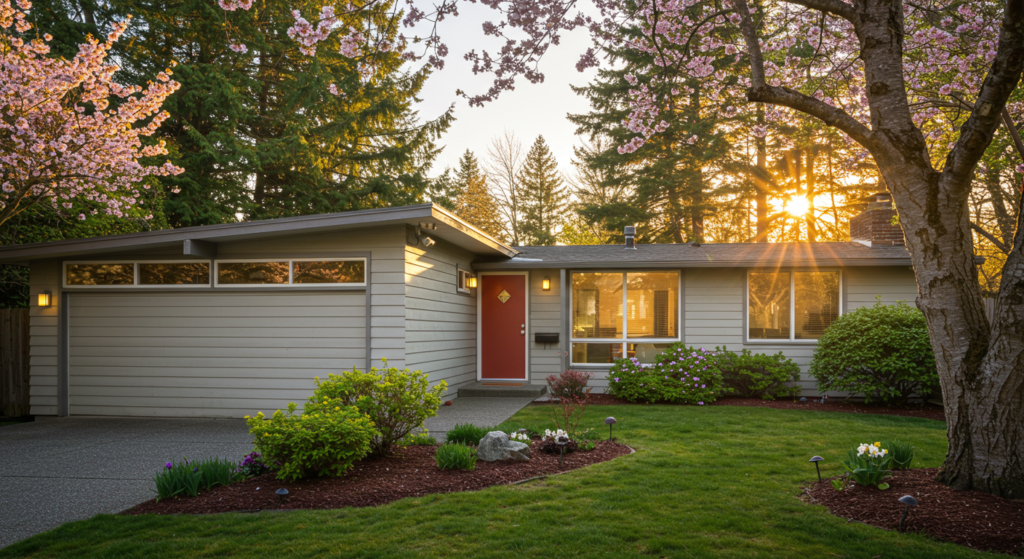
You know that moment when you really FEEL it? After touring any number of homes and mostly feeling . . . not much of anything, you walk into a place and now it’s different. This could actually be the one! The light is perfect, the layout makes sense, and you can truly envision yourself living there and making it a home.
That feeling isn’t just luck—it’s what happens when a home’s design aligns with your needs, both now and in the future.
When considering features for long-term comfort in Portland homes, it’s important to think beyond just today’s needs. The fields of environmental gerontology and universal design have extensively researched how our living environments affect health, independence, and quality of life as we age. These research-backed principles, combined with practical experience in Portland’s housing market, show that certain key elements consistently make the difference between a house that may work for a while and a home that continues to meet your needs year after year.
Let’s explore nine essential features to consider for your next Portland home that will provide lasting comfort, convenience, and day-to-day satisfaction.
1. Single-Level Living or First-Floor Primary Suite
Perhaps no feature has a greater impact on long-term comfort than having your essential living spaces on a single level. Whether that’s a ranch-style home, an arts and crafts bungalow, or a larger house with a complete first-floor primary suite, single-level living eliminates one of the most common obstacles to aging comfortably: stairs.
In Portland’s diverse neighborhoods, you’ll find a variety of options. While West Hills properties often feature multiple levels due to terrain, many homes in areas like Milwaukie, parts of Northeast Portland, and Lake Oswego offer single-level floor plans that don’t sacrifice character or charm.
When evaluating potential homes, consider:
- Is there a true primary bedroom suite (including a full bathroom) on the main floor?
- Are kitchen, dining, and living areas also on this level?
- If laundry is important on the main floor, is there space to accommodate it?
- Is the entry point level or easily modified with a ramp if ever needed?
Even if stairs aren’t a challenge now, having this flexibility built into your home provides valuable peace of mind. You might happily use upper or lower levels for guests, hobbies, or additional living space, while knowing your essential daily needs can be comfortably met on a single floor.
2. Thoughtful Bathroom Design
Bathrooms are often the first place where traditional home design falls short as our needs evolve. A thoughtfully built bathroom incorporates what builders call “universal design” principles—features that work beautifully for people of all ages and abilities.
Look for bathrooms that include:
- A curbless (zero-entry) shower or one with a very low threshold
- Grab bars (or at minimum, proper blocking in the walls for future installation)
- Comfort-height toilets (slightly taller than standard fixtures)
- Good lighting, particularly around the vanity area
- Non-slip flooring materials
- A wider doorway (at least 32″ clear width, ideally 36″)
In Portland’s older homes, bathrooms often need updating, but that can be an opportunity to create exactly what you want. Neighborhoods like Sunnyside, Buckman, and Eliot have many charming vintage homes where updated bathrooms marry modern functionality with period-appropriate aesthetics.
When touring homes, pay particular attention to the primary bathroom configuration. Could you navigate it comfortably if you were temporarily using a walker? Is there enough space for two people to use it without constantly navigating around each other? These considerations significantly impact daily comfort.
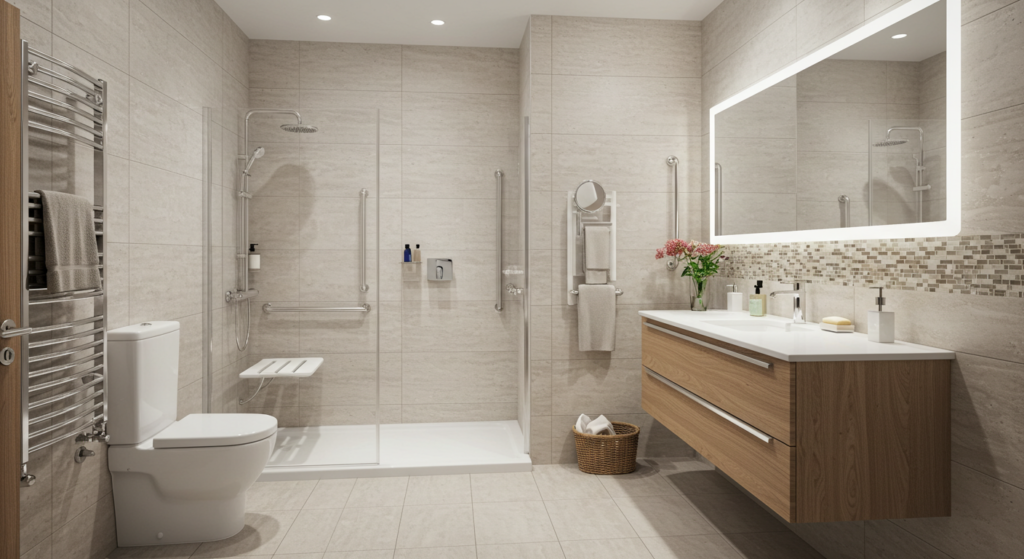
3. Strategic Storage Solutions
The right storage solutions transform how a home functions day-to-day. Instead of focusing solely on volume (though that matters), evaluate the quality and accessibility of storage throughout potential homes.
Features to prioritize include:
- Kitchen cabinets with pull-out shelves
- Closets with adjustable systems that can be reconfigured as needs change
- Storage that minimizes the need to reach high or bend low
- Built-in organization systems that maximize efficiency
- Adequate storage on the main living level
In Portland, where older homes are abundant, look for those that have been thoughtfully updated to incorporate these features while maintaining architectural integrity. Neighborhoods like Alameda, Beaumont-Wilshire, and parts of Southwest Portland often feature homes with generous storage that can be easily adapted.
Remember that storage isn’t just about having enough space—it’s about having the right kind of accessible space that works for your specific lifestyle. The ability to easily find, reach, and use your belongings has a significant impact on daily comfort and independence.
4. Natural Light and Layered Lighting Systems
Portland’s famously gray winters make thoughtful lighting essential for both practical function and emotional wellbeing. Homes with abundant natural light and well-designed lighting systems create spaces that feel welcoming year-round.
When evaluating potential homes, look for:
- Generous windows, particularly with eastern or southern exposure
- Skylights or solar tubes in interior spaces
- Layered artificial lighting (ambient, task, and accent lighting)
- Easy-to-operate light switches, ideally positioned at entries to each room
- Smart lighting systems that can be controlled remotely or via voice commands
Neighborhoods like Gladstone, Grant Park, and Hillsdale often feature homes positioned to capture excellent natural light. During home tours, visit properties at different times of day to understand how light changes throughout the space, especially during our darker months.
Don’t underestimate the impact of good lighting on safety, either. Well-lit pathways, stairways, and transitions between rooms significantly reduce fall risk. This is particularly important in Portland’s older homes where level changes between rooms are still common.
5. Accessible Outdoor Spaces
Portland’s natural beauty and moderate climate make outdoor living spaces an essential feature for long-term enjoyment. The right outdoor spaces extend your living area and keep you engaged with nature year-round.
Look for homes that feature:
- Easy access to outdoor spaces (minimal steps, wide doorways)
- Covered areas for enjoying the outdoors regardless of weather
- Low-maintenance landscaping or space for raised garden beds
- Privacy from neighbors while maintaining a connection to the community
- East or south-facing exposure for morning light and afternoon warmth
Even smaller spaces can offer tremendous value when thoughtfully designed. In neighborhoods like Concordia, Richmond, and Multnomah Village, you’ll find homes with charming yards that provide both privacy and community connection without overwhelming maintenance.
Consider how you might adapt the outdoor space for different seasons and changing abilities. Could a portion be converted to raised beds if kneeling becomes difficult? Is there a protected area where you could enjoy morning coffee even during our rainy months? These features enhance your daily living experience in a way only nature can.

6. Community Proximity and “Third Places”
While not a physical feature of the home itself, a property’s location relative to community amenities significantly impacts long-term livability. Environmental gerontology research highlights the importance of “third places”—locations outside home and work where people gather and connect.
When evaluating neighborhoods in Portland, consider proximity to:
- Grocery stores and everyday services
- Libraries, community centers, and places of worship
- Coffee shops, restaurants, and gathering spaces
- Medical facilities and healthcare providers
- Parks and natural areas
- Public transportation options
Portland excels in creating walkable neighborhoods with vibrant “third places.” Areas like Multnomah Village, Sellwood, Hollywood, and St. Johns provide excellent examples of communities where daily needs are accessible within a comfortable walking distance.
The ability to easily reach these places—whether walking, driving, or using public transportation—becomes increasingly valuable over time. It supports continued independence, community connection, and overall wellbeing in ways that isolated locations simply can’t match.
7. Climate Control and Energy Efficiency
Portland’s climate is generally moderate, but our increasingly warm summers and occasional cold snaps make effective climate control essential for comfort and health. Energy-efficient homes also provide long-term financial benefits through lower utility costs.
Features to prioritize for long-term comfort include:
- Efficient heating systems with zoned control when possible
- Air conditioning or heat pump systems (increasingly important with our warming summers)
- Proper insulation and weather-sealing
- Energy-efficient windows appropriate for our climate
- Smart thermostats for programmed comfort and energy savings
Many of Portland’s charming older homes have been updated with these systems while preserving their character. Neighborhoods like Woodstock, Rose City Park, and Burlingame often feature homes with thoughtful energy upgrades that balance efficiency with architectural integrity.
When touring potential homes, don’t hesitate to ask about utility costs throughout the year and any recent energy-efficiency improvements. These features contribute not only to your physical comfort but also to environmental responsibility and financial stability.
8. Flexible Spaces for Evolving Needs
Homes that can adapt to changing circumstances provide tremendous value over time. Flexible spaces allow you to modify your environment as your interests, health needs, or family circumstances evolve.
Look for features like:
- A layout that could accommodate main-floor living if needed
- Rooms that could serve multiple purposes (home office, guest room, hobby space)
- Space that could be converted to accommodate a caregiver if ever needed
- Areas that can adapt to changing mobility without major renovations
- Opportunities for technology integration as needs change
In Portland’s diverse housing market, many homes offer this flexibility. From the classic bungalows of Ladd’s Addition to the mid-century ranch homes in Raleigh Hills, options exist across various price points and architectural styles.
When evaluating potential homes, try to envision multiple scenarios. Could the dining room double as a craft space? Might a den serve as an occasional guest room? Could a portion of the garage be converted to a workshop or studio? This adaptability ensures your home continues to serve you well through life’s many transitions.
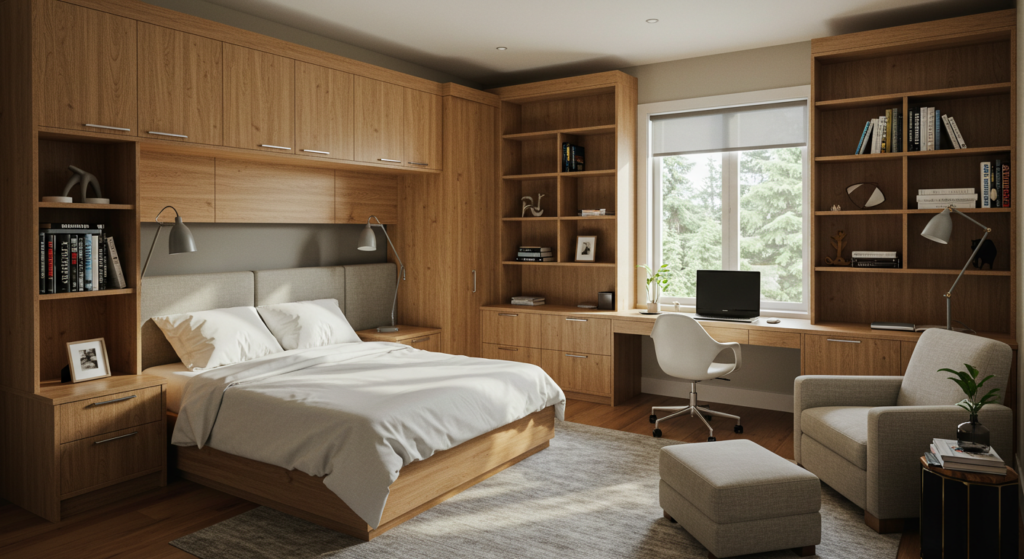
9. Smart Home Features Worth Considering
While technology shouldn’t complicate your life, thoughtfully incorporated smart home features can significantly enhance long-term comfort and security. The key is selecting systems that are intuitive and truly useful rather than novelties.
Consider the value of:
- Voice-controlled lighting, temperature, and entertainment systems
- Smart security features including doorbell cameras and monitoring systems
- Automated or remotely controlled window coverings
- Water leak detection systems
- Fall detection and emergency response integration
These features can be added to homes of any age, though newer construction in areas like South Waterfront, the Pearl District, and parts of Happy Valley often includes them as standard. The advantage of retrofitting an existing home is the ability to select exactly the features that best serve your specific needs.
When exploring smart home options, prioritize systems with simple interfaces, reliable performance, and good customer support. The goal is technology that quietly enhances your life rather than becoming another thing to manage.
Finding Your Perfect Long-Term Portland Home
The most comfortable homes combine thoughtful physical features with the less tangible elements that make a house truly feel like home. Your ideal space might not check every box on this list, but understanding which features matter most to you will guide your search more effectively.
Remember that many features can be added or modified if you find a home that’s right in other important ways. A thoughtful renovation can transform a challenging bathroom into an accessible one, or convert a traditional kitchen into a model of universal design. The key is recognizing which elements are essential from the start and which you’re willing to adapt over time.
As you explore Portland’s diverse neighborhoods and housing options, take time to imagine your daily routines in each space. How would morning coffee feel in this kitchen? How many friends could you fit in this living room? Does the primary bedroom provide the peaceful retreat you deserve? These everyday moments ultimately define your experience far more than any single design feature.
Your next home shouldn’t just meet your needs today—it should continue to support your evolving lifestyle for years to come. By prioritizing these nine essential features, you’re not just finding a house; you’re creating the foundation for your next chapter in Portland, one of America’s most livable cities.
Ready to explore local homes with these long-term comfort features in mind? I’d love to help you find the perfect match for your lifestyle now and in the future. Schedule a no-pressure consultation to discuss your specific needs and discover options that might surprise and delight you.
Thanks for reading : )
Peter Lindberg
Lead Broker – Silver Compass Property Group
Senior Real Estate Specialist (SRES)
503-806-4277

